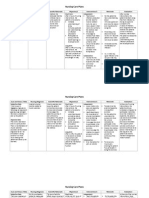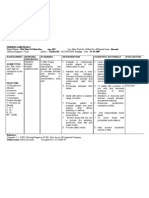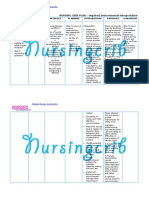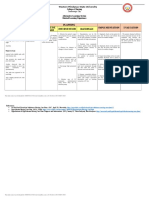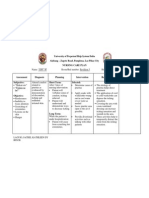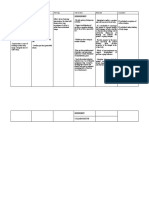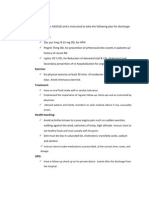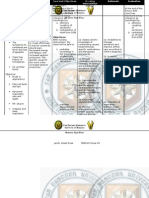NCP
NCP
Uploaded by
Alynna ValbuenaCopyright:
Available Formats
NCP
NCP
Uploaded by
Alynna ValbuenaOriginal Title
Copyright
Available Formats
Share this document
Did you find this document useful?
Is this content inappropriate?
Copyright:
Available Formats
NCP
NCP
Uploaded by
Alynna ValbuenaCopyright:
Available Formats
Alynna Cherise T.
Valbuena N4A
NURSING CARE PLAN
ASSESSMENT
Subjective: The patient complaints of easy fatigability. Objective: BP: 160/90 Protruding abdomen with purple striae over the abdomen and buttocks Round face Develoment of facial hair Numerous bruises on the skin Thin lower extremities Difficulty climbing from one stair to another Diagnostic tests reveal the ff: Glucose: 186 mg/dl Na: 152 mEq/L K: 3.2 mEq/L Ca: 4.3 mEq/L Cortisol: 35 ug/dl
DIAGNOSIS
Activity Intolerance r/t muscle weakness and fatigues as manifested by inability to maintain usual routines.
PLANNING
After 8 hours of nursing intervention, the patient will achieve slight increase in activity tolerance evidenced by acceptable level of fatigue/weakness.
INTERVENTIONS
Assess sleep patterns and note changes in thought processes/behaviors.
RATIONALE
Multiple factors can aggravate fatigue, including sleep deprivation, emotional distress, side effects of medication, and progression of disease process. Prevents overexertion, allows for some activity within patient ability.
EVALUATION
After 8 hours of nursing intervention, the patient has achieved slight increase in activity tolerance evidenced by acceptable level of fatigue/weakness.
Recommend scheduling activities for periods when patient has most energy. Adjust activities as necessary, reducing intensity level/discontinuing activities as indicated. Encourage patient to do whatever possible, e.g., self-care, sit in chair, visit with family/friends. Instruct patient/family/caregiver in energy conservation techniques. Stress necessity of allowing for frequent rest periods following activities. Demonstrate proper performance of ADLs, ambulation/position changes. Identify safety issues, e.g., use of assistive devices, temperature of bath water, keeping travel-ways clear of furniture. Encourage nutritional intake/use of supplements as appropriate.
Provides for sense of control and feeling of accomplishment.
Enhances performance while conserving limited energy, preventing increase in level of fatigue.
Protects patient/caregiver from injury during activities.
Necessary to meet energy needs for activity.
You might also like
- Nursing Care Plan For Liver Cirrhosis NCPDocument14 pagesNursing Care Plan For Liver Cirrhosis NCPderic92% (12)
- NCP CoughDocument4 pagesNCP CoughKingJayson Pacman06No ratings yet
- Nursing Care Plan 2Document2 pagesNursing Care Plan 2Isabel Barredo Del MundoNo ratings yet
- Dermatomyositis NCPDocument3 pagesDermatomyositis NCPMakki MarcosNo ratings yet
- NCP LymphedemaDocument1 pageNCP Lymphedemayasira50% (2)
- NCPDocument13 pagesNCPLee Da HaeNo ratings yet
- FNCP For Community UTI ProblemDocument9 pagesFNCP For Community UTI ProblemAlynna Valbuena100% (1)
- Pedia With LeukemiaDocument14 pagesPedia With LeukemiaAlynna ValbuenaNo ratings yet
- NCPDocument7 pagesNCPAbbie TantengcoNo ratings yet
- Actual NCPDocument2 pagesActual NCPbaki0146No ratings yet
- NCP For Activity IntoleranceDocument1 pageNCP For Activity IntoleranceKristine LonyenNo ratings yet
- NCP GrandcaseDocument5 pagesNCP GrandcaseSaima BataloNo ratings yet
- Health Teaching Plan DyspneaDocument3 pagesHealth Teaching Plan DyspneaMae JavierNo ratings yet
- Disturbed Sleep Pattern Related To Environmental FactorsDocument9 pagesDisturbed Sleep Pattern Related To Environmental Factorsalaisah dimaporoNo ratings yet
- Gout N C P BY BHERU LALDocument1 pageGout N C P BY BHERU LALBheru LalNo ratings yet
- Nursing Care PlanDocument4 pagesNursing Care PlanAlvin DagumbalNo ratings yet
- Or NCP (Impaired Elimination)Document1 pageOr NCP (Impaired Elimination)Nikki M. ArapolNo ratings yet
- Biopsy: Assessment Diagnosis Planning Intervention Rationale EvaluationDocument5 pagesBiopsy: Assessment Diagnosis Planning Intervention Rationale EvaluationDan HizonNo ratings yet
- NCP HypertensionDocument1 pageNCP HypertensionCharisse VillanuevaNo ratings yet
- Teaching Plan: Involution (Bubble He)Document4 pagesTeaching Plan: Involution (Bubble He)Pamela BagabaldoNo ratings yet
- Delayed Growth NCPDocument3 pagesDelayed Growth NCPPau-pau BasiNo ratings yet
- Nursing Care Plan - Impaired Physical MobilityDocument2 pagesNursing Care Plan - Impaired Physical MobilitySusan Croce57% (7)
- Activity IntoleranceDocument2 pagesActivity IntoleranceSenyorita KHaye100% (4)
- Nursing Care Plan For Impaired Environmental Interpretaion NCPDocument4 pagesNursing Care Plan For Impaired Environmental Interpretaion NCPderic100% (3)
- NCP Close Complete Fracture Knowledge DeficitDocument2 pagesNCP Close Complete Fracture Knowledge DeficitArt Christian Ramos0% (1)
- Body Weakness NCPDocument1 pageBody Weakness NCPtwicetrashNo ratings yet
- Ineffective Breathing Pattern Pneumonia Nursing Care PlanDocument1 pageIneffective Breathing Pattern Pneumonia Nursing Care PlanJasonlee Baluyot100% (1)
- Nursing Care PlanDocument4 pagesNursing Care PlanKath RubioNo ratings yet
- Nursing Care Plan: References: Nurse's Pocket Guide Pages 151-155Document1 pageNursing Care Plan: References: Nurse's Pocket Guide Pages 151-155Caroline ChaNo ratings yet
- NCP AlteredDocument3 pagesNCP AlteredShaira TillahNo ratings yet
- NCP (Deficient Fluid VolumeDocument3 pagesNCP (Deficient Fluid VolumeNica RespondoNo ratings yet
- Nursing Care PlanDocument3 pagesNursing Care Planagentlara28No ratings yet
- Nursing Care PlanDocument10 pagesNursing Care PlanMalou SanNo ratings yet
- NCP - AnxietyDocument1 pageNCP - AnxietyNovie Carla100% (1)
- FATIGUE NCP Que Fransis A.Document4 pagesFATIGUE NCP Que Fransis A.Irene Grace BalcuevaNo ratings yet
- Word Ncp.......... TetanusDocument6 pagesWord Ncp.......... TetanusaianrNo ratings yet
- NCPDocument4 pagesNCPMichelleNo ratings yet
- NCP Acabo Hypokalemia 1Document2 pagesNCP Acabo Hypokalemia 1Doneva Lyn MedinaNo ratings yet
- CHAPTER 5 Nursing Care PlanDocument5 pagesCHAPTER 5 Nursing Care PlanMiguelito Galagar GultianoNo ratings yet
- NCP NutritionDocument2 pagesNCP NutritionBuhkz HermosoNo ratings yet
- NCPDocument3 pagesNCPbjhilario100% (1)
- Self Care DeficitDocument1 pageSelf Care DeficitPaul Edmer Corcuera RN100% (1)
- NCPDocument1 pageNCPJachel Kathleen LaguioNo ratings yet
- NCP Disturbed Body ImageDocument2 pagesNCP Disturbed Body ImageDoneva Lyn MedinaNo ratings yet
- CAD Discharge PlanDocument2 pagesCAD Discharge PlanmamiudamNo ratings yet
- Health Teaching For Infection ControlDocument2 pagesHealth Teaching For Infection ControlZaijean Kate Dianne LigutomNo ratings yet
- Skin IntegrityDocument2 pagesSkin IntegrityJonica CamposNo ratings yet
- Discharge Plan For AppendectomyDocument1 pageDischarge Plan For AppendectomyMyra AtuleNo ratings yet
- Nursing Care Plan Peptic UlcerDocument3 pagesNursing Care Plan Peptic UlcerJefferson Baluyot PalmaNo ratings yet
- Ineffective Breathing Pattern Pneumonia Nursing Care PlanDocument1 pageIneffective Breathing Pattern Pneumonia Nursing Care Planjustin_saneNo ratings yet
- Impaired Tissue Integrity BurnDocument1 pageImpaired Tissue Integrity BurntabaloveNo ratings yet
- Discharge PlanDocument5 pagesDischarge PlanDenise Louise PoNo ratings yet
- NCP StressDocument2 pagesNCP StressWaqas Javed100% (7)
- Nursing Care Plan For Ineffective Airway ClearanceDocument6 pagesNursing Care Plan For Ineffective Airway ClearanceCaroline ChaNo ratings yet
- NCP For HPNDocument2 pagesNCP For HPNara_balusNo ratings yet
- Com +Nursing+Care+Plan+Chicken+PoxDocument2 pagesCom +Nursing+Care+Plan+Chicken+PoxDahl Obañana Erojo100% (2)
- Nursing Care Plan - 1 AlyanaDocument1 pageNursing Care Plan - 1 AlyanaKen100% (1)
- Goboy - Risk For Infection NCPDocument3 pagesGoboy - Risk For Infection NCPLouise GermaineNo ratings yet
- NCP Nephrolithiasis FeverDocument1 pageNCP Nephrolithiasis Feverm_r0se_k0h100% (1)
- NCP FinalDocument18 pagesNCP FinalJessica Medina100% (1)
- NCP (Fatigue)Document1 pageNCP (Fatigue)student_019100% (1)
- Nursing Care PlanDocument9 pagesNursing Care PlanjmichaelaNo ratings yet
- Revised ResearchDocument14 pagesRevised ResearchAlynna ValbuenaNo ratings yet
- ArthritisDocument2 pagesArthritisAlynna ValbuenaNo ratings yet
- First and Second Level of Assessment Inadequate Living SpaceDocument2 pagesFirst and Second Level of Assessment Inadequate Living SpaceAlynna Valbuena60% (5)
- First and Second Level of Assessment Unsanitary Waste DisposalDocument2 pagesFirst and Second Level of Assessment Unsanitary Waste DisposalAlynna Valbuena50% (2)
- Abruptio PlacentaDocument11 pagesAbruptio PlacentaAlynna ValbuenaNo ratings yet
- Nutrition Function Food SampleDocument3 pagesNutrition Function Food SampleAlynna ValbuenaNo ratings yet



